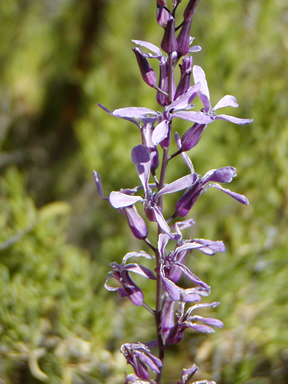Howell's thelypody facts for kids
Quick facts for kids Howell's thelypody |
|
|---|---|
 |
|
| Thelypodium howellii spectabilis | |
| Conservation status | |
| Scientific classification | |
| Genus: |
Thelypodium
|
| Species: |
howellii
|
Thelypodium howellii, also known as Howell's thelypody, is a very rare plant. You can find it in the Western United States. It grows only in a small area. This area is where the states of Oregon, Nevada, and California meet. This means it is endemic to that specific region.
Contents
What Does Howell's Thelypody Look Like?
Howell's thelypody is a biennial. This means it lives for two years. It often has some hairs. But sometimes it can be smooth and waxy. It grows a thin, branching stem. This stem can stand up to 70 centimeters tall. That's about 2.3 feet!
Most of its leaves grow in a circle. This circle is called a rosette. It forms around the bottom of the plant. Leaves higher up on the stem might wrap around the stem.
The flowers grow in a cluster. This cluster is called an inflorescence. It's a type of cluster called a raceme. This means the flowers are spaced out along the stem. The flowers have greenish-white or purplish outer parts. These are called sepals. The petals are pale blue or purple. They are shaped like spoons.
After the flowers, the plant makes a fruit. This fruit is called a silique. It can be up to 4.5 centimeters long. Inside, it holds plump brown seeds.
Different Types of Howell's Thelypody
There are two main types, or subspecies, of Howell's thelypody:
- Thelypodium howellii subsp. howellii
- Thelypodium howellii subsp. spectabalis - This one is also called Howell's spectacular thelypody.
Where Does Howell's Thelypody Live?
This plant grows only in a small area. This area stretches from northeastern Oregon to northeastern California. It likes to live in special places. These include alkaline or adobe meadows. It also grows in wet areas near rivers. You can find it in moist plains. These areas are often part of the Great Basin sagebrush scrub. Scientists are still learning about how fire affects this plant.
Why Is Howell's Thelypody Rare?
Many groups are working to protect this plant. The United States Forest Service in the Pacific Southwest Region lists it as a Sensitive Species. The California Native Plant Society also lists it as rare. NatureServe gives it a Global Rank of G2. This means it is very rare and at risk.
The Oregon Department of Fish and Wildlife says it is endangered in Oregon. A lot of its natural home has been turned into farms. This is a big problem. Other threats include:
- Invasive weeds: These are plants that grow fast and take over. They compete with Howell's thelypody for space and water.
- Changes in water flow: How water moves through the land can change. This can make its habitat too dry or too wet.
- Cattle grazing: Cows eating the plants can reduce their numbers.
- Mowing: Sometimes, areas are mowed before the plant can grow and make seeds.
How to Spot Howell's Thelypody
You can see Howell's thelypody flowering from May to July. The subspecies spectabilis is found only in Malheur County, Oregon. This type is larger than howellii. It also has bigger, more purple flowers. This subspecies is listed as a federally protected species.


